Located in the heart of Rajasthan, Mandawa is a true hidden gem of India. Famous for its haveli, luxurious historical palaces renowned for their fascinating wall paintings, Mandawa is like a decadent open-air museum. Astonishing frescoes decorate the majestic haveli, princely palaces from bygone eras. Around the corner, rubbish piles up in the alleys. While waiting for this exceptional, surprisingly un-touristy city to be developed as it deserves, in this article you can read about its hidden wonders and why to visit it.
Table of Contents
Understanding haveli: history and architecture of Mandawa’s ancient palaces
The haveli are a fascinating part of the history and architecture of Mandawa. The city prospered from its strategic location along the Silk Road, one of Asia’s most important trade routes. Through international trade, the merchants of Mandawa were able to accumulate considerable wealth, often surpassing even that of the kings of Jaipur. They decided to display their social status through the architecture of their houses.
PLAN YOUR TRIP TO INDIA
When in India, stay connected at the best rates by purchasing an Airalo eSIM online before your trip. This eliminates the hassle of purchasing a physical SIM at the airport.
About travel insurance, Heymondo is the way to go. They offer comprehensive coverage against unexpected events like medical emergencies, trip cancellations, lost luggage, and more. Heymondo provides excellent value for money and will give you peace of mind on your travels!
The haveli, the residences of the merchants, were designed with the intention of impressing visitors. The façades were decorated with intricate wall paintings depicting religious motifs, deities and sacred animals, created using natural colours from local stones and minerals. The frescoes on the walls of the haveli are unique and fascinating works of art, reflecting the history of Rajasthan.
However, when the British government chose Calcutta as its new capital, all trade shifted. Mandawa then experienced a period of decline and neglect. The city later became a tourist destination in the 1980s when it was included in a French travel guide. Even today, most visitors to Mandawa come from France or Germany. The city is often described as an open-air gallery, when in British guidebooks it is barely mentioned.
At the time of my visit, many haveli in Mandawa are closed to the public. Others have been converted into restaurants and hotels to accommodate tourists. Only half of Mandawa’s Chokhani Double Haveli has been turned into a museum. There is also a plan to musealise the Shamiram Gadiya Haveli. Other haveli are in a state of disrepair due to neglect by private owners. This makes government intervention in restoration difficult, but they are still visible from outside.

The haveli of Mandawa: the city’s main historical buildings
The haveli of Mandawa represent a fascinating chapter in Indian architecture of the late 19th and early 20th century. Today, their intricate facades and carved wooden doors greet visitors with a sense of wonder. The haveli marked by green signs, although not all of them are in perfect condition, are true gems. Some are more interesting than others because of the subjects depicted and their state of preservation.
One of the distinctive features of these haveli are the wall paintings that often narrate the epic cycle of the Ramayana. These works of art tell stories of gods, heroes and ancient legends, immersing visitors in India’s rich mythology. Most of the paintings focus on traditional themes. However, some haveli feature more modern artwork, about things and activities introduced during the British colonial period. Scenes of tiger hunting with rifles, trains or even the first aeroplanes are some examples.
The architecture of the haveli reflects a fusion of Muslim and Rajasthani influences. In the haveli you can often see the characteristic toothy arches typical of Rajasthan. These buildings have large meeting areas for merchants and rooms for all members of the extended families who lived there. The haveli still have a significant impact on the local economy today. In fact, they provide work in hotels and restaurants, but also for the maintenance and care of the buildings.
Haveli of Murmuria: the palace with modern frescoes
Built by a Rajput merchant, the Murmuria Haveli in Mandawa boasts a series of paintings that include images of cars, trains, King George V and Venetian-style landscapes. There are also images of the god Krishna with cows and Prime Minister Jawaharlal Nehru on horseback with the national flag. You can also admire a long fresco depicting a train with a crow flying over the engine.
Jhunjhunwala Haveli: the palace of mirrors
Built in 1859, the Jhunjhunwala Haveli is a magnificent example of traditional Rajasthani architecture. It is most famous for its fretwork windows and wooden doors that set it apart from others. The architectural beauty of this structure leaves every visitor spellbound. Every corner of the haveli is beautifully designed, conveying the idea of the royalty of its owners and the skill of the artists of the time. The spacious rooms have high ceilings, windows are decorated with fretwork carvings and the walls with frescoes depicting Krishna with the Gopis or shepherdesses.
Haveli of Goenka: the palace of murals
Considered to be an open-air art gallery, the Goenka Haveli dates back to the 18th century. It is named after the Goenka family who once lived in this mansion. The walls are decorated with paintings and frescoes recalling the cultural history of Rajasthan and numerous images of the god Krishna. Despite its abandonment, the opulence of yesteryear still remains intact and pristine. Spacious, arched doors are signs of grandeur and testify to the precision of the craftsmen.
Chokhani Double Haveli: the two brothers’ twin palaces
The Chokhani Double Haveli is unique in that it is a symmetrical double palace. It was built in the 18th century by two brothers, both Rajput merchants. One of the palaces has now been ‘restored’ in Indian style. That means it was repainted in bright colours. The other palace instead has continued its slow decay but retained its original decorations.
Only one half of the twin haveli, the repainted one, is officially open to the public as a museum. You can visit both by passing through the communal areas, with the encouragement of the caretakers. The structure of the Chokhani Double Haveli has a façade featuring frescoes of camels and horses. There are two separate entrances and communal areas inside.
The visit allows you to discover how the wealthy Rajput merchants lived. For example, in the courtyard you can see a room dedicated to storing water for drinking in earthenware jars to keep it fresh and jars of medicinal herbs. In the master bedroom you can still see the fan manually operated by a servant outside on a rope, while the niches of the oil lamps tell you how they were specially designed to avoid soiling the interior walls.
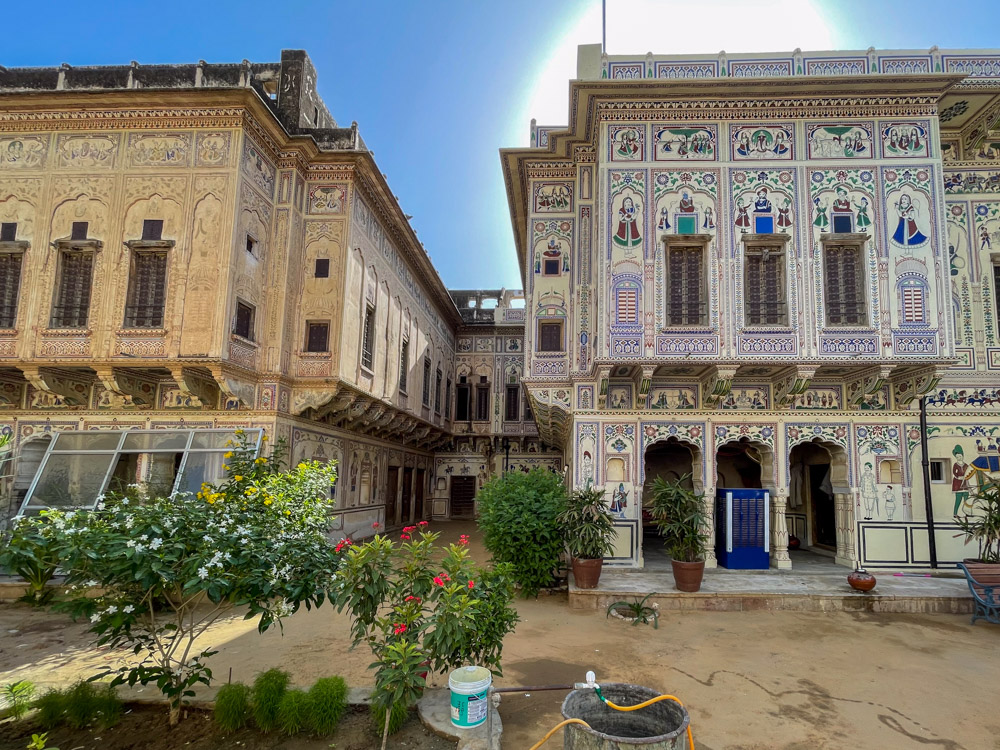
Gold Haveli: the palace painted gold
The Gold Haveli is known as the gold-painted palace because it was indeed decorated with gold leaf. This haveli was supposed to be an authentic work of art, but unfortunately today it is closed to visitors. Its history is shrouded in the luxury and opulence of yesteryear, when the walls shone with gold details reflecting the wealth of the owners. Although it is not possible to explore the interior of the Gold Haveli, its name evokes the image of an extraordinary and fascinating place that has retained its charm over the centuries.
Banshidhar Haveli: the palace with the Wright Brothers’ plane
Built in 1921, the Banshidhar (or Binshidhar) Haveli is best known for the Wright Brothers’ aeroplane fresco, as well as scenes of everyday life telling stories of a bygone era. Although currently closed to visitors, you can admire British planes, bicycles, trains and cars on the outside walls of the haveli.
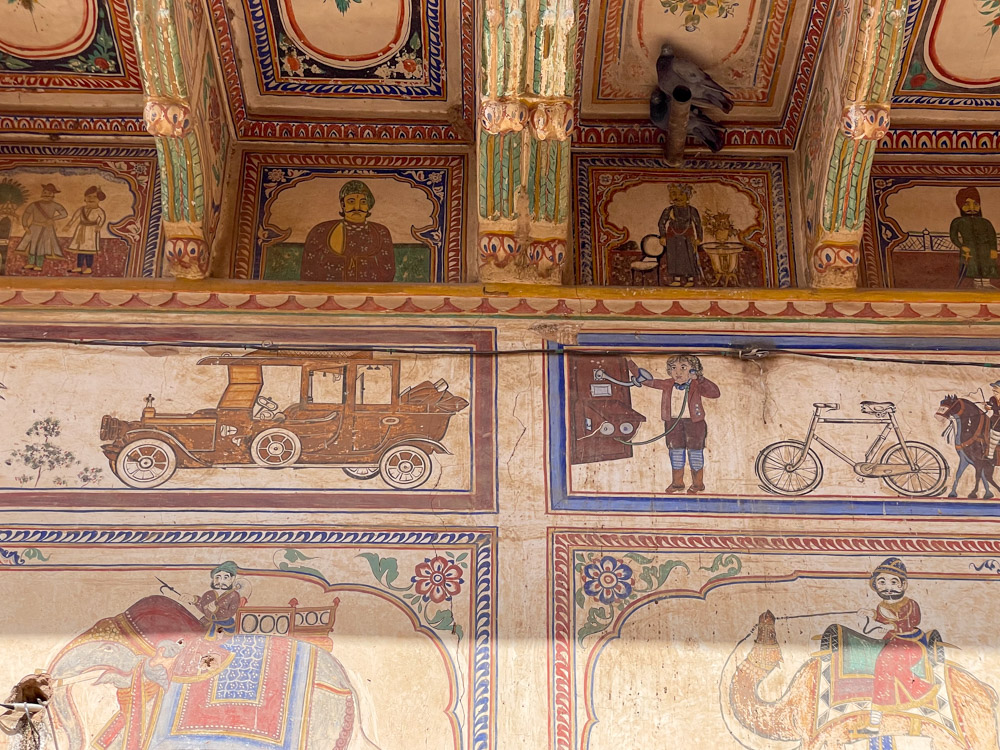
Shamiram Gadiya Haveli: former noble residence, soon museum
The Shamiram Gadiya Haveli from an abandoned noble residence is about to be reborn as a museum. It was recently acquired for this purpose. At the time of my visit, it still looked neglected, but you could still admire the beautiful traditional architecture of Mandawa.
Sonthaliya Haveli: the palace with the train
The Sonthaliya Haveli can be recognised from the other buildings decorated by the steam train on the façade. Get someone local to help you find it. The directions in the Lonely Planet guide to Rajasthan tend to confuse it with another haveli among those with modern decorations.
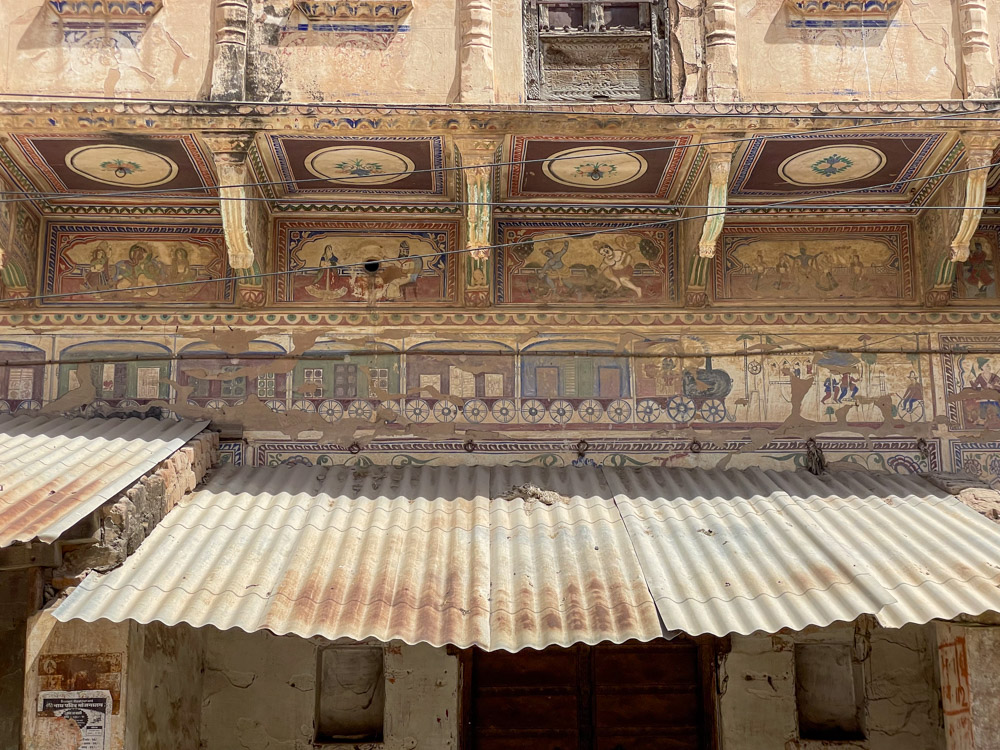
Additional things to do in Mandawa
Besides the tour of the haveli, you can also see water harvesting wells in Mandawa. Stepwells and wells are an important testimony to the engineering mastery of the past. Next to the ancient well where water was collected with a bucket, built to make up for the lack of water in Rajasthan, you can see the modern rainwater harvesting cistern.
Another activity you can do in Mandawa is the camel ride. I preface this by saying that I am not keen on activities with animals. Unfortunately, according to our guide, we could not miss it. Tourists are put on a cart and ride through Mandawa, passing by the haveli. Then they’ll admire the sunset from a sand dune on the edge of town.
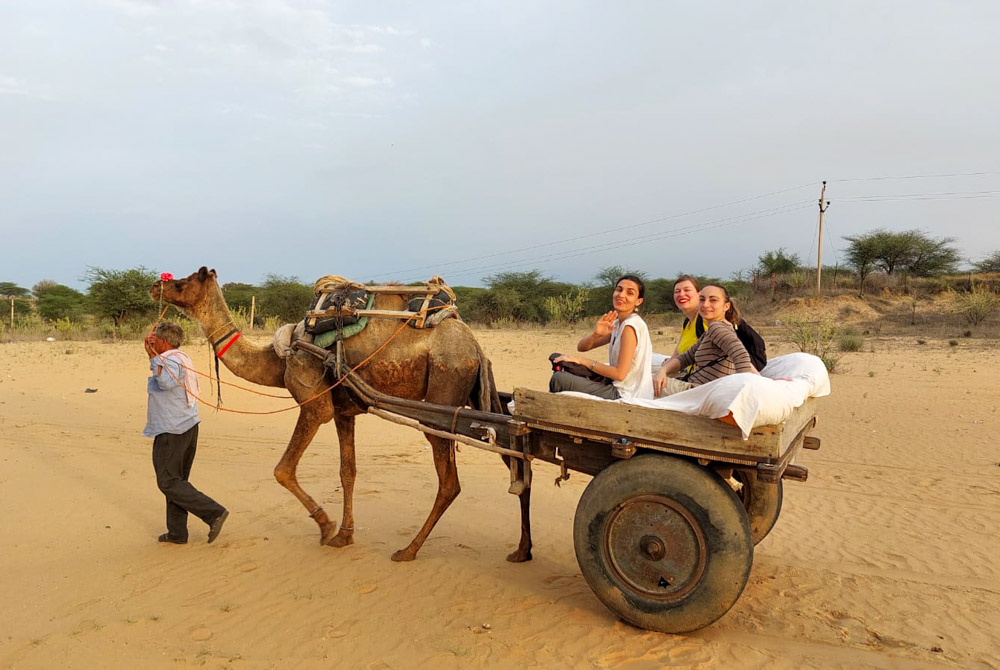
Where to sleep in Mandawa: the experience of sleeping in an authentic Indian palace
If you decide to stay in Mandawa to have more time to see all the haveli, you can choose from different types of accommodation. The city offers a variety of options, from traditional haveli turned into hotels to cheaper accommodations such as guesthouses, or elegant luxury resorts outside the city.
Haveli hotels are definitely the best choice to immerse yourself in the history and rajputi architecture of Mandawa. These restored palaces offer an authentic experience and allow guests to live in the same rooms that were once home to wealthy merchants. These accommodations often feature original frescoes, luxurious rooms and a unique atmosphere.
Mandawa Haveli Hotel
Among the haveli hotels located in Mandawa, I have tried and recommend the Mandawa Haveli Hotel, a charming period palace for the experience of sleeping in an authentic historical mansion. This haveli has been restored to offer spacious rooms with private bathrooms and air conditioning. Each room is beautifully decorated, with details that recall the charm of Rajasthan.
The highlight of the Mandawa Haveli Hotel is its beautiful garden, which also houses the Rasoi Restaurant where you can enjoy delicious, authentic Rajasthani cuisine. From the terrace on the rooftop of the building, you can admire the magical atmosphere of sunrise or sunset over Mandawa.
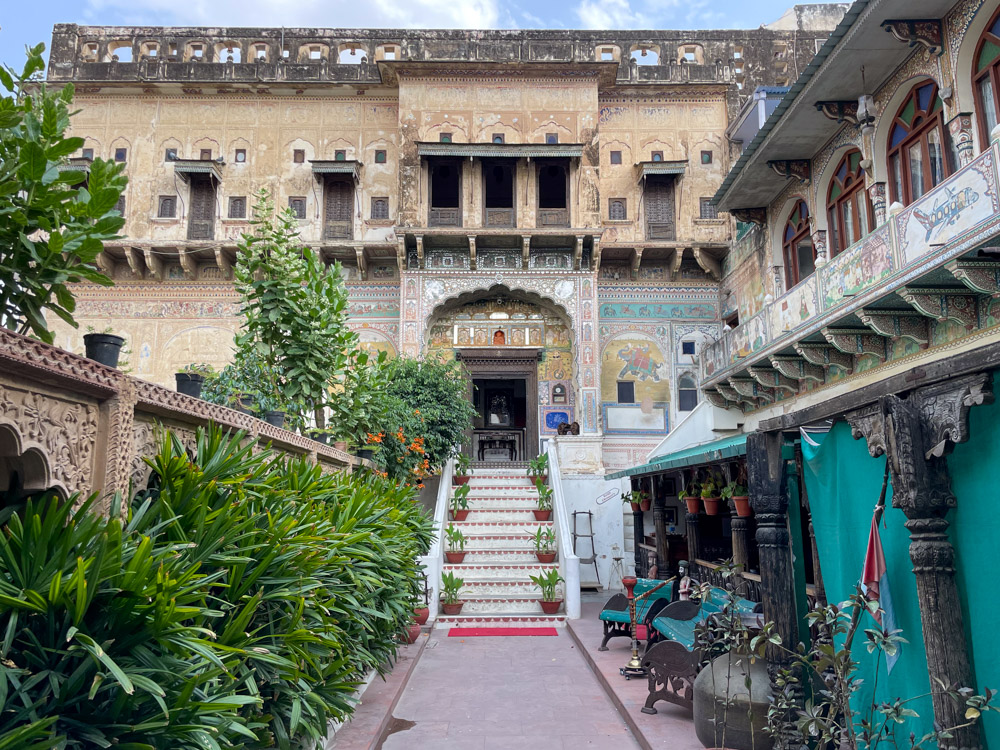
Getting to Mandawa: transportation options to reach the city
Mandawa was once an important trading crossroads along the Silk Road in Rajasthan. Today, however, it is a minor town with a limited flow of tourists. This allows you to admire its beautiful haveli without crowds, but at the same time there are fewer connections than in the more popular tourist destinations. For this reason, it may be difficult to reach it independently.
The best way to reach Mandawa is by bus or private car, but I do not recommend renting a car because of the heavy traffic and the unscrupulous driving style of Indian drivers. Personally, I visited Mandawa on a tour of Rajasthan and it was an excellent option because I didn’t have to worry about transportation and the guide explained all the peculiarities of the haveli. A good alternative is to book a private tour from Jaipur, with an English-speaking guide.
Visiting Mandawa, a city often overlooked by mass tourism, is an experience that will immerse you in the history and architecture of Rajasthan through its magnificent palaces. Write to me in the comments if you are already familiar with Mandawa and its haveli and if they could become a stop on your Rajasthan trip.
